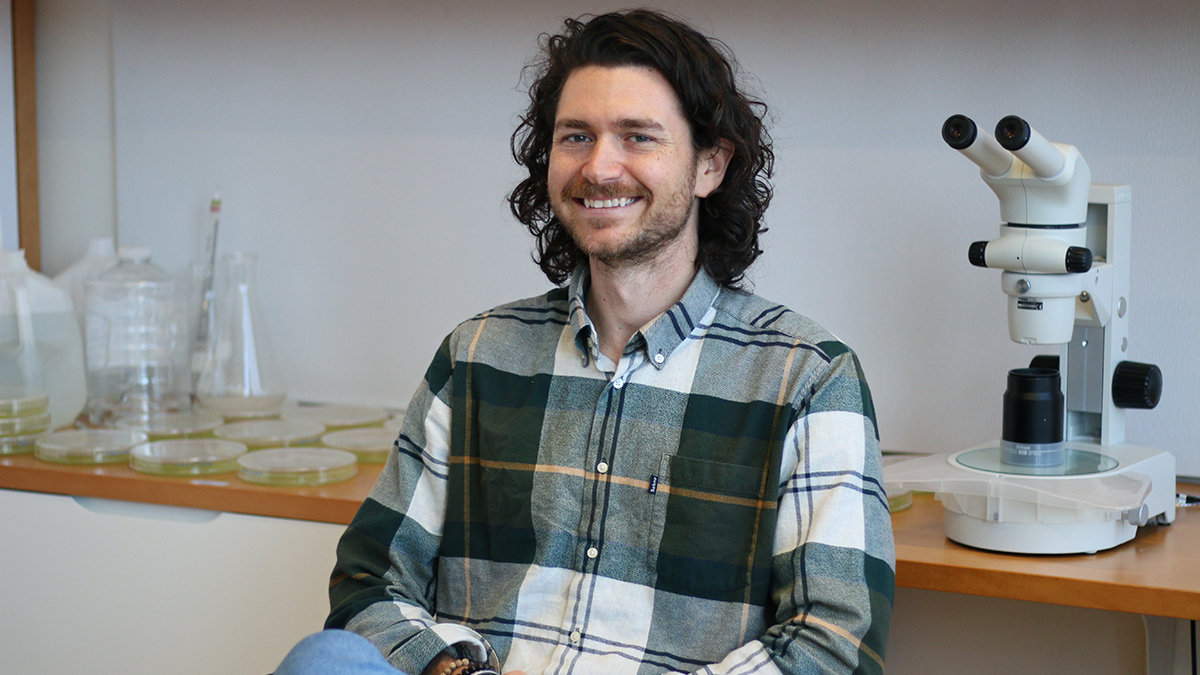The survivors
Heat-resistant. Cold-weather tough. Outer space savvy. Tardigrades are survivors above all else. But what makes them so resilient? Thomas Boothby strives to figure that out and hopes to discover how they can be used to refrigerate biological samples.

“Can I see one?”
“Yeah, of course!” Thomas Boothby crosses the room and approaches the petri dish-covered countertop that lines the entire left wall of his office in UNC’s Genome Sciences Building. He slides one of the plates under the microscope, adjusts the focus, and then steps aside.
“You see those little grains of rice moving around?” he asked. “Those are tardigrades.”
The opaque creatures move haphazardly, stumbling as they make their way from one side of the dish to the other. Gummy bears. Tiny blimps. Overstuffed couches with eight legs. This is how people describe these microscopic animals, which have been on our planet for about 500 million years. They’re like little sumo wrestlers pacing around before the next fight.
Even more fascinating than their appearance, tardigrades have an almost supernatural ability to survive extreme environments — from the bottom of the ocean to the Antarctic tundra, the Sahara Desert and even outer space.
While tardigrades can be found almost anywhere, even on the moss-covered tree in your backyard, the scientists who study them cannot. Boothby, a Carolina biologist, is one of just a handful. “There are definitely labs out there that use tardigrades,” he says, “but they’re not often looking at the molecular processes for how they survive drying out.”
Boothby began studying tardigrades because they piqued his curiosity. “I’m fascinated by how certain organisms survive environmental extremes,” he said.
Only later did he envision their potential for improving agriculture, treating human diseases, and preserving biologic samples like vaccines.
Boothby is currently is partnering with Cellphire — a biotech company focused on cell stabilization technology — to use proteins from tardigrades to develop technologies that will stabilize vaccines and whole blood in dry state. If successful, the groundbreaking research could make it much easier to maintain blood supplies in areas that lack reliable access to refrigeration, such as in military zones and at hospitals and clinics in developing countries.
Plants and animals
Boothby’s tardigrade research didn’t begin until he came to UNC-Chapel Hill in 2013. Before that, as a University of Maryland Ph.D. student, he was studying one specific part of a fern’s life cycle. “Random, right?” he laughs. But there was something special about these plants that captured Boothby’s attention: In order to develop properly, they must dry out.
“Most plants, you know, you want to water them every week or whatever,” he said. “But these — if you do not let them dry up to the point where their leaves become crispy dust, then their spores never develop into new plants. And I just got really interested in how something can lose all that water and essentially die and protect itself in such a way that, when you add water back into the system, it can start going again. We can’t do that. Most other plants and animals can’t do that. How is that possible?”
For his postdoctoral research, Boothby wanted to move beyond plants and into an animal system. He chose tardigrades for a few reasons. At the time, there wasn’t much molecular or genetic research on them — there still isn’t, really — but there were tools readily available to study them. Plus, their closest relatives, fruit flies and nematodes, are familiar ones.
“At the basic level, tardigrades are just like every other animal,” Boothby said. “They are multicellular, they have organ systems, they have a digestive track, they have a nervous system.”
So far, scientists have discovered more than 1,200 species of tardigrades. They are found on every continent, in all sorts of conditions from a parking lot puddle to the Himalayas. “Whenever someone goes out looking for a new species of tardigrades, they almost always find one,” Boothby said. They vary in size and diet, but one thing remains constant: They are survivors.
Protein webs
Most of Boothby’s research on tardigrades looks at the genomic changes that occur when they dry out. If humans can understand this process, Boothby believes, one future application could be engineering crops that can cope with the stresses of extreme environments like drought. But learning the mechanism behind how tardigrades do this is key.
Tardigrades have a unique family of genes that produce what are called intrinsically disordered proteins. Unlike other proteins, these lack a defined three-dimensional structure. “They’re like chains of beads that are floating around in space and constantly changing shape,” Boothby said. “And when tardigrades dry out, they start producing these proteins like crazy.”
When Boothby prevented production of these proteins within tardigrades and then dried them out, the animals died. But when he inserted the genes that make those proteins into other organisms such as yeast, they became 100-times more resistant to drying out. “That was a pretty good indication that those proteins are necessary for surviving drying,” he said.
But how do these proteins accomplish this? With help from Carolina chemist Gary Pielak, Boothby discovered that these proteins form a gel-like network that looks like a three-dimensional spiderweb, which, Boothby believes, prevents other proteins from unfolding and combining — an event that, in humans, can lead to diseases like Alzheimer’s.
“Tardigrades produce proteins that are, essentially, the same as the ones in humans,” Boothby points out. “But when their cells get heated up or frozen or dried out, they start producing these disordered proteins, which form interconnected gel fibers that encapsulate and protect the other proteins that would normally get broken by stress.”
This means tardigrade proteins might have the potential to treat diseases. At least, it’s a very distant possibility, according to Boothby.
“The gels seem to keep proteins from unfolding and destabilizing, which in humans and other animals can lead to some diseases,” he said. “But, right now, applying the tardigrade proteins to prevent or reverse protein unfolding in human disease is just a dream.”




